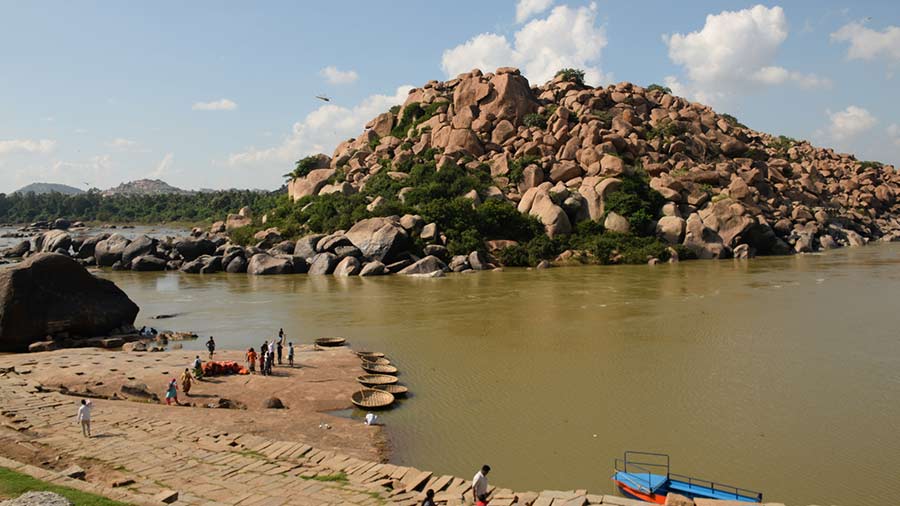Lalitgiri, Ratnagiri and Udayagiri are some of the most popular tourist destinations when it comes to Buddhist historical places in Odisha, but there is one more place that was mentioned by Hiuen Tsang when he had travelled across India visiting various monasteries and stupas. He referred to this place as Pu-Sie-Po-Ki-Li or as the historians say “Pushpagiri”.
The problem faced by archaeologists was that none could perfectly pinpoint the location of Pushpagiri as excavations around Lalitgiri, Ratnagiri and Udayagiri did not reveal anything regarding Pushpagiri.

Remains of the main stupa on Langudi Hill
Around 1995-1996, an excavation was carried out at Langudi Hill, which is located in the Jajpur district of Odisha in very close proximity to Lalitgiri, Ratnagiri and Udayagiri. When the excavation work was being carried out a small fragment of the inscription was discovered with the words Sri Pushpasabharagirayah written in Brahmi script, which when translated read something like this: “The Illustrious mountains with the load of flowers”. Another Brahmi inscription also discovered here had the words Konasakkhay which meant “Off the staff (bearing) school (sect)”.
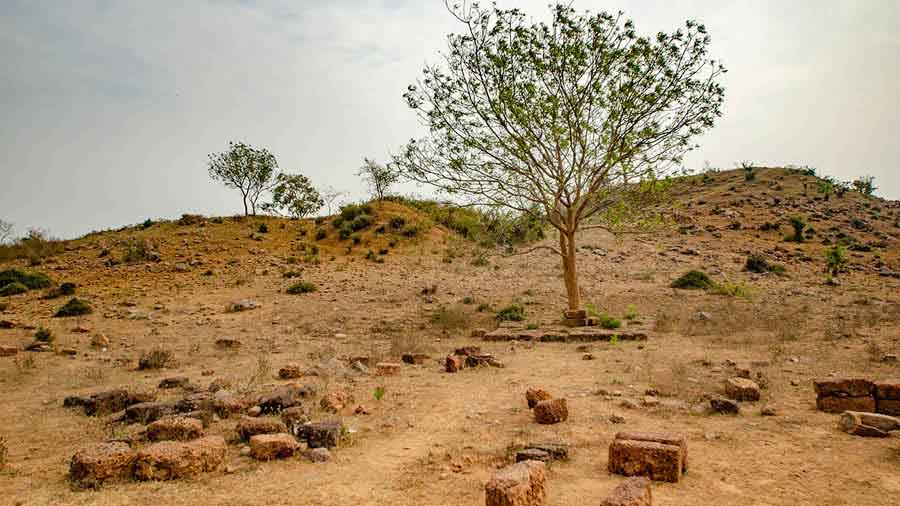
Scattered stone blocks on Langudi hill
The third inscription discovered here had the words (Pu)phagiri Kak-k(a), nana-haladharakasa, Prarachavalasa, which when translated reads as “Of Prarachavala the ploughman of Pushpagiri Kanana (garden)”.
The final piece of the puzzle was the inscription Pispasiriviha(r)e, which meant “In the monastery of Pishpagiri (Pushpagiri)”.
Historians after seeing these discoveries out here at Langudi Hill could safely conclude that this was the very Pu-Sie-Po-Ki-Li of Pushpagiri that Hiuen Tsang had visited when he traveled across this region of India.
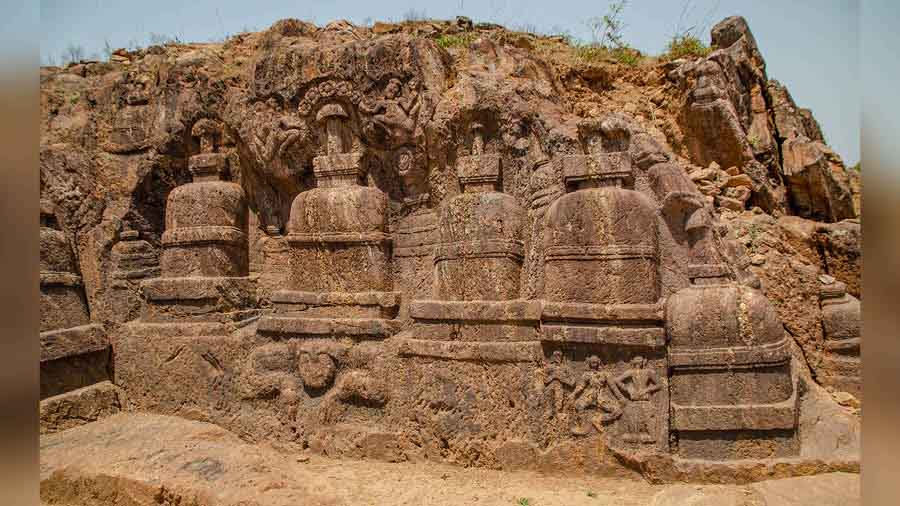
Rock-cut stupas and votive stupas on Langudi Hill
A second set of excavations was done between 1999 – 2000 and that led to the discovery of other fragments along with other artifacts. During this second excavation, another important inscription fragment was found with the words Ami Upasaka Asokasa Samchiamana Agra Eka Thupe written. This was very significant as when translated this meant “In prominent stupa of the accumulated height of Ashoka”. This translation can be directly related to the fact that Ashoka, one of the greatest rulers of the subcontinent and also it was known that he helped propagate Buddhism and had built several stupas in his lifetime, was the very person who built Pushpagiri.
What you can see on Langudi Hill now
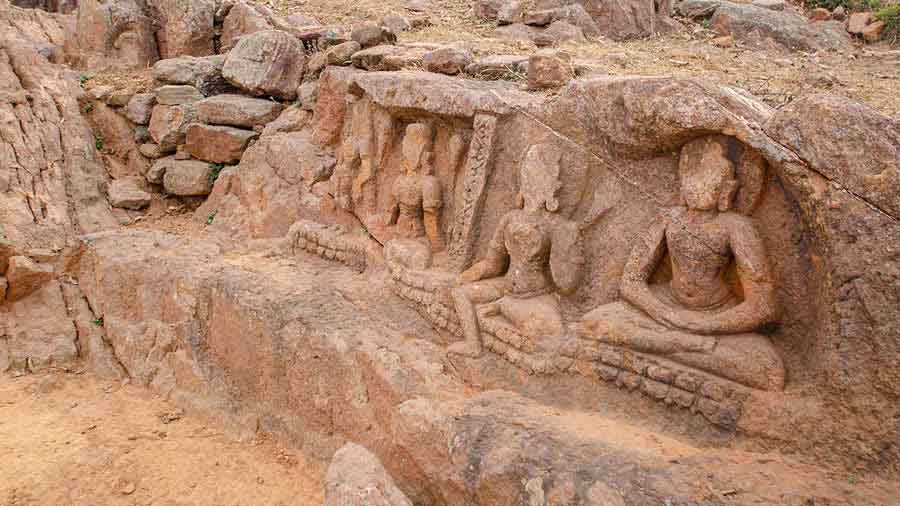
Dhyani Buddha (Samadhi Mudra), Tara and four-armed Prajnaparamita, Avalokitesvara
Due to the massive popularity of Lalitgiri, Ratnagiri and Udayagiri, tourists keep visiting these three places and often ignore Pushpagiri. Another factor is that the hill is yet to be excavated completely. One can still see pits dug by the Archaeological Survey of India around different spots.
When you climb to the top of the hill, you can see the remains of a large stupa. Only the foundation structure can be seen and all around this structure you will see scattered pieces of laterite stones and terracotta bricks and by its shape, you can make out that these were once part of a massive building.

Figures of humans on rock-cut stupas and votive stupas
Another 50 metres east of this stupa foundation you will find a series of rock-cut small votive stupas. Most of these votive stupas have been carved out of the rock face of the hill and there is only one, which still has some visible three-dimensional shape.
If you walk towards the south side of the hill, almost to the top, which faces the stupa foundation you will find some rock-cut sculptures of Buddha and Tara. Most of these again have been carved out of the rock face of the hill.
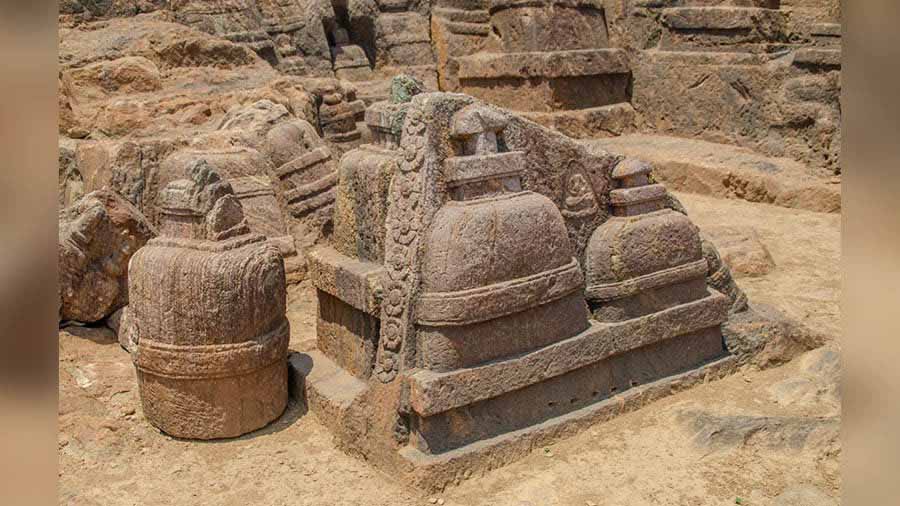
Votive stupas
The figures out here are that of Dhyani Buddha (Samadhi Mudra), Tara, four-armed Prajnaparamita, Avalokitesvara, Buddha in Bhusparsa Mudra, etc.
Towards the northeast section of the hill, you will find remains of recent excavations. All around this spot, you can make out the remains of some bigger structures, which most probably could have been the monastery.

Excavation site on Langudi Hill
Once complete excavation is done around the hill, it is assumed that more such structural remains will be visible and finally the grand Pushpagiri Vihara, built by Ashoka, would see the light of day.
Travel information

Excavation site on Langudi Hill
- If you are visiting Lalitgiri, Ratnagiri and Udayagiri, then you can easily accommodate a short detour to Langudi Hill.
- There are no tickets or entry restrictions out here. If you happen to find the gates closed, do request the security staff to let you in as visitors.
- From a distance, the hill will look very much barren, as most of the excavated sites won’t be visible from the foot of the hill. You can request the security staff out there to guide you towards the different structures.
- Keeping in mind that this is not a popular tourist destination, it is recommended that you visit this place during the day and avoid late afternoon slots.
- Summer-time temperatures easily cross 45 degrees Celsius, thus be prepared Carry water bottles, as the climb to the top of the hill can be a good exercise.
— Working for more than a decade in the book retail and publishing industry, Subahdip Mukherjee is an IT professional who is into blogging for over 15 years. He is also a globetrotter, heritage lover, and photography enthusiast.


